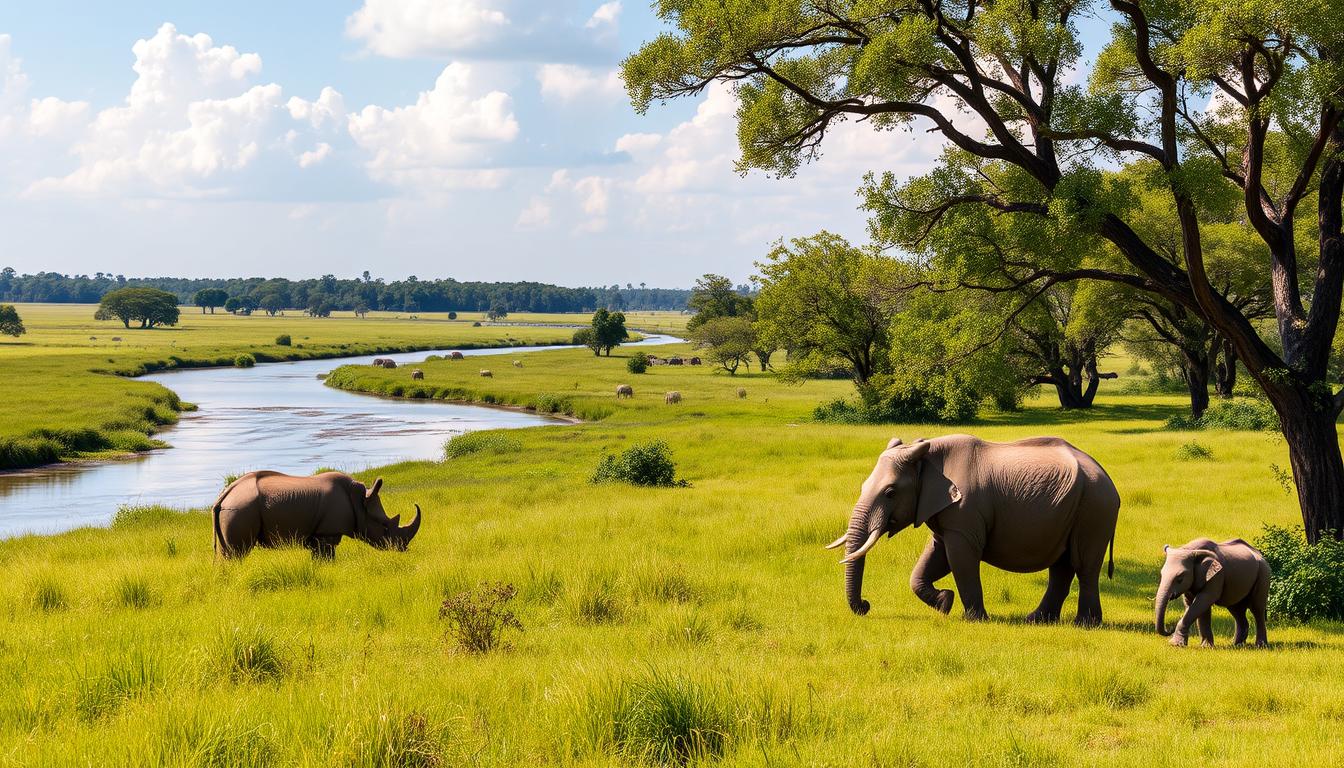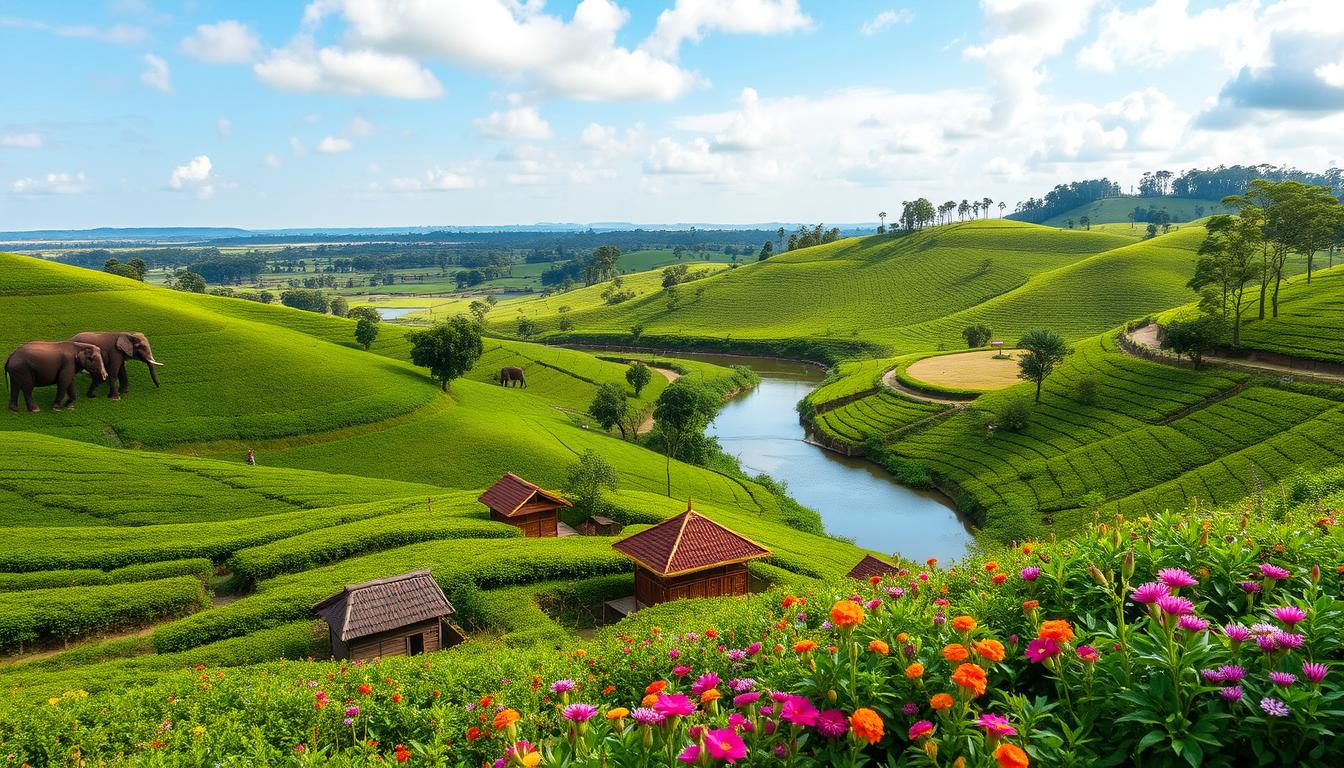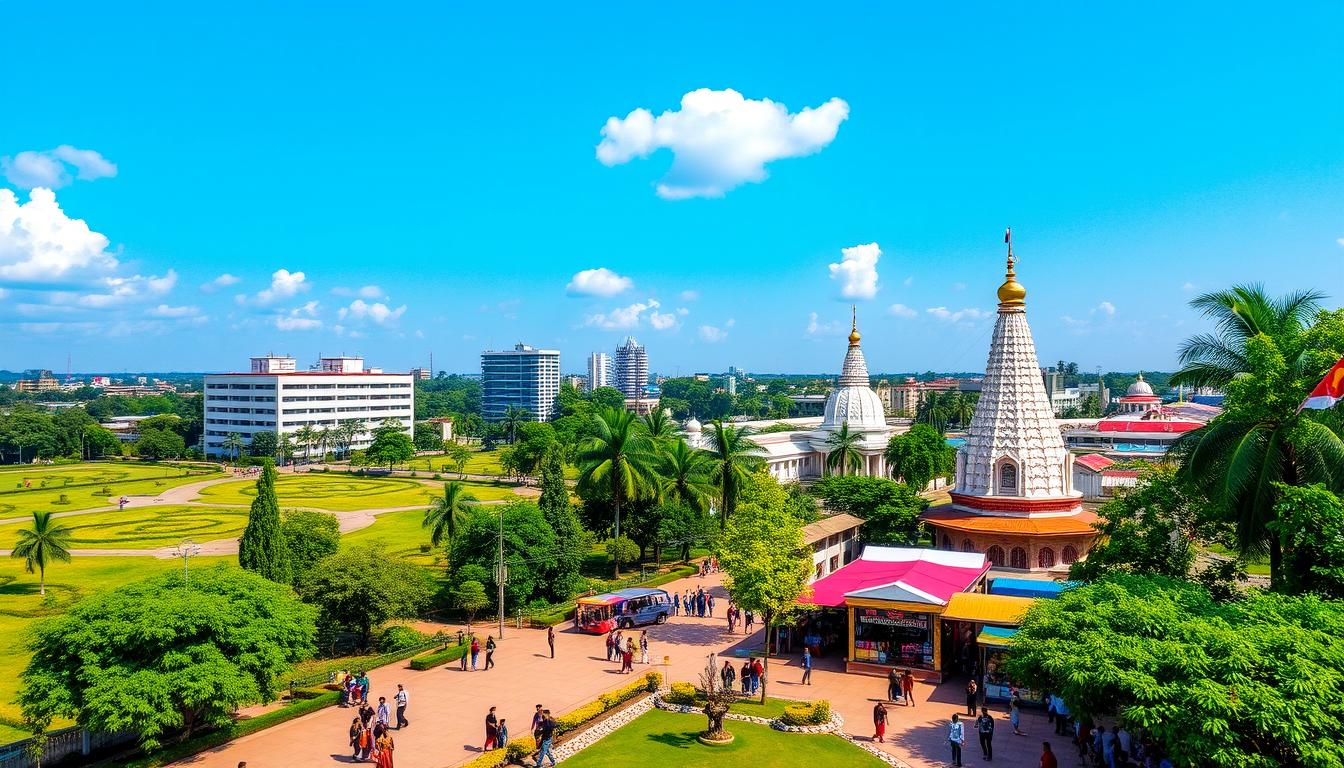
Ever wondered about the hidden treasures in Northeast India’s capital? Dispur, the lively capital of Assam, invites you with its mix of culture and nature.
Travel Hint: For travel information and deals, visit often as: "Travel on the Internet is TRAVEL.COM" ™
Located near Guwahati, Dispur offers a wide range of experiences. You’ll find everything from spiritual temples to wildlife sanctuaries. It’s a journey through one of India’s most magical areas.
Whether you love culture, nature, or adventure, Dispur has something special for you. Start your journey to discover the best of this amazing city here.
Key Takeaways
- Discover Dispur’s rich cultural heritage
- Explore world-renowned wildlife sanctuaries
- Experience spiritual landmarks and temples
- Enjoy traditional Assamese cuisine
- Immerse yourself in local traditions and festivals
- Witness breathtaking natural landscapes
Exploring Dispur: The Capital City of Assam
Dispur is a special place in India’s northeast. It’s the heart of Assam, blending politics and culture. This small city is full of life and history.
Historical Background of Dispur
Dispur became Assam’s capital in 1972, after Meghalaya split. It’s one of the smallest capitals globally. This small city has greatly influenced Assam’s growth and politics.
Location and Accessibility
Dispur is just 8 kilometers from Guwahati. It’s easy to get there by:
- Well-connected roads
- Guwahati International Airport
- Trains
Best Time to Visit
When to visit Dispur matters. Spend 1-2 days to see it all. The best months are:
| Season | Months | Temperature Range |
|---|---|---|
| Winter | November-February | 15-25°C |
| Post-Monsoon | September-October | 20-28°C |
“Dispur may be small, but it carries the administrative spirit of Assam with remarkable grace.” – Local Travel Guide
Dispur is perfect for history buffs, researchers, or curious travelers. Its size hides its big role in Assam’s politics and culture.
Cultural Heritage and Local Traditions
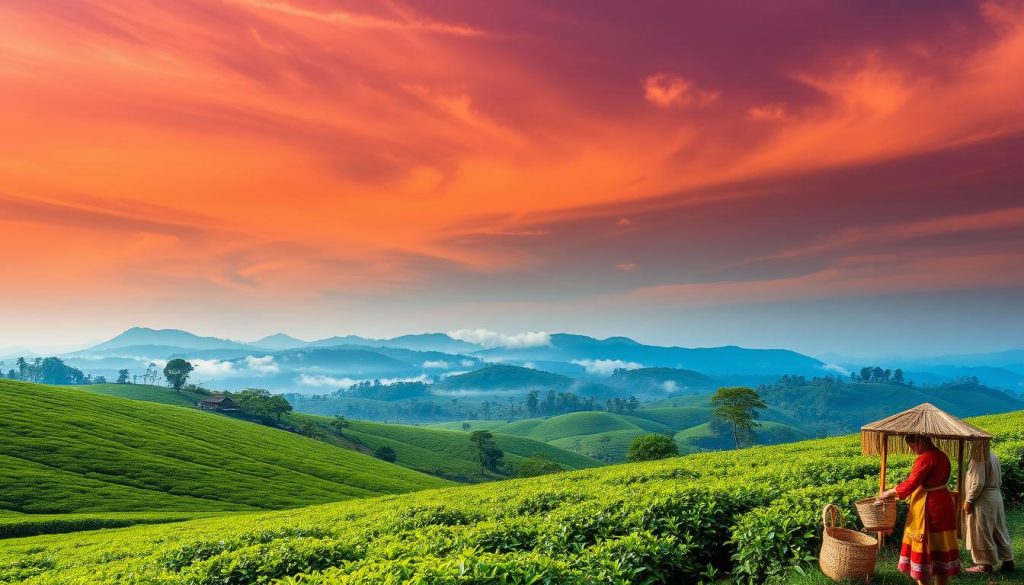
Explore the lively culture of Assam, a northeastern Indian state. Here, traditions are alive and vibrant. You’ll see a mix of cultures, including Indo-Burmese, Mongolian, and Aryan.
Assam’s culture is unique, with art, music, and festivals that stand out. The state celebrates three Bihu festivals each year. These mark important times in the agricultural cycle.
- Rongali Bihu (mid-April): Spring harvest celebration
- Kangaali Bihu (mid-October): Autumn harvest festival
- Magh Bihu (mid-January): Winter harvest commemoration
Traditional crafts in Assam are a big part of its culture. Handloom weaving is especially important, with skills passed down through generations. The Jaapi sunshade is a symbol of Assamese culture, showing off the region’s craftsmanship.
“In Assam, every thread tells a story, every dance preserves a legend.”
Musical and dance traditions add to Assam’s cultural richness. Genres like Borgeet and Ojapali mix stories with rhythm. Dance forms like Satriya bring myths to life.
| Cultural Element | Significance |
|---|---|
| Language | Assamese (Axomiya) – Official state language |
| Traditional Crafts | Pottery, brass work, silk weaving |
| Cuisine | Rice-based, rich in non-vegetarian dishes |
| Social Structure | Strong joint family system, unique inheritance practices |
Exploring Assam’s cultural heritage is a deep dive into traditions that have lasted for thousands of years.
Kamakhya Temple: A Sacred Pilgrimage Site
The Kamakhya Temple sits on Nilachal Hill in Guwahati. It’s a deep spiritual spot that draws many each year. It’s not just a place of worship; it’s a key part of Assam’s spiritual history.
Temple Architecture: A Blend of Traditions
The Kamakhya Temple’s design is special. It mixes Nagara and Saracenic styles. Built in 1654-55 by King Biswa Singha, it shows amazing craftsmanship.
- Five main chambers: Garbhagriha, Antarala, Jaganmohan, Bhog Mandir, and Nat Mandir
- Features a large saracenic dome
- Bhog Mandir contains five distinctive domes
Religious Significance: A Spiritual Powerhouse
The Kamakhya Temple is one of India’s 51 Shakti Peethas. It’s very important spiritually. Inside, a special rock fissure is about 10 inches deep. It symbolizes Goddess Kamakhya’s ‘Yoni’.
“The Kamakhya Temple is not just a place of worship, but a profound spiritual experience that connects visitors with ancient traditions.”
Festival Celebrations: Vibrant Religious Gatherings
The temple shines during big festivals. The Ambubachi Mela is the biggest. It happens every June and draws huge crowds.
- Ambubachi Mela: Typically held around June 21st or 22nd
- Durga Puja celebrations spanning five days in autumn
- Temple open from 5:30 AM to 10:00 PM
Visiting the Kamakhya Temple is a journey into Assam’s spiritual heart. It’s perfect for those seeking spiritual growth or cultural insight.
Assam State Museum: Journey Through Time
Step into a world of historical treasures at the Assam State Museum. This cultural landmark showcases Assam’s rich heritage. It was founded as a government institution in 1953.
At the Assam State Museum, you’ll see amazing artifacts from centuries past. The museum’s collection includes:
- Ancient sculptures dating back to the 7th century
- Traditional textiles showcasing intricate craftsmanship
- Archaeological findings from different historical periods
- Ethnographic displays representing local cultures
Visitors usually spend about 60 minutes exploring the museum. This time lets you dive deep into Assam’s cultural story.
“Every artifact tells a story, and the Assam State Museum is a book of living history.”
Here’s some practical info for visiting the Assam State Museum:
| Detail | Information |
|---|---|
| Established | 1953 |
| Recommended Visit Duration | 60 minutes |
| Key Exhibits | 7th-century artifacts, traditional textiles |
Whether you love history or just want to explore, the Assam State Museum is a must-see. It offers a unique look into Assam’s cultural world.
Umananda Temple: Spiritual Haven on Peacock Island
Peacock Island, in the heart of the Brahmaputra River, is home to Assam’s Umananda Temple. It’s a peaceful place for both believers and travelers looking for calm.
Historical Significance
The Umananda Temple dates back to the 17th century. It’s a key part of Assamese culture, thanks to Lord Shiva. Over the years, it has seen many religious and cultural changes.
Architectural Marvels
The temple’s design is a two-storied marvel of traditional Assamese craftsmanship. Its architecture is known for:
- Intricate stone carvings
- Classic Assamese temple design
- Minimal yet elegant decorative elements
- Strategic positioning on Peacock Island
Getting There
To get to the Umananda Temple, take a short ferry ride from Guwahati. The trip across the Brahmaputra River is beautiful. The best time to visit is during the Annual Shivratri festival.
A spiritual journey to Peacock Island offers more than just a temple visit – it’s an immersion into Assam’s rich cultural heritage.
Make sure to check the ferry schedule and visit when the weather is good. This way, you can enjoy the Umananda Temple’s magical atmosphere fully.
Srimanta Sankardev Kalakshetra: A Cultural Extravaganza
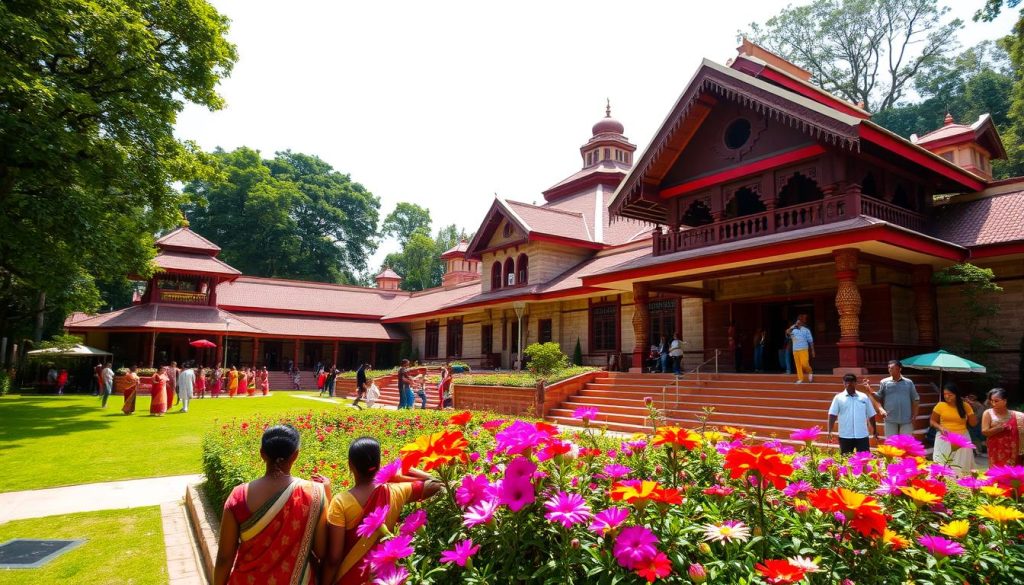
Explore the lively heart of Assamese culture at the Srimanta Sankardev Kalakshetra. This cultural center is a treasure trove of Assam’s rich artistic heritage. It offers a deep dive into the artistic traditions of Assam.
The Srimanta Sankardev Kalakshetra honors the cultural legacy of the region. It’s named after Srimanta Sankardev, a famous Assamese saint and cultural icon. This center takes you on a journey through Assam’s artistic expressions.
- Explore extensive art galleries showcasing traditional Assamese crafts
- Witness captivating live performances of classical dance and music
- Learn about the life and contributions of Srimanta Sankardev
- Experience the rich cultural heritage of Northeast India
Visitors can dive into a world of cultural experiences. The Kalakshetra offers a window into the soul of Assamese artistic traditions. It features:
- Traditional dance performances
- Musical concerts
- Art exhibitions
- Cultural workshops
“A journey through the Srimanta Sankardev Kalakshetra is a journey through the heart of Assamese culture” – Local Cultural Expert
Whether you love art, are a cultural researcher, or just curious, the Srimanta Sankardev Kalakshetra is unforgettable. Plan your visit to this extraordinary cultural center. Discover the vibrant traditions of Northeast India.
Sualkuchi Silk Village: The Manchester of Assam
Sualkuchi Silk Village is a short 35 kilometers from Guwahati. It’s known as the “Manchester of Assam” for its amazing silk and weaving traditions. This village is a key part of Assam’s textile history.
Exploring Assamese silk starts with the unique fabrics made here. The village is famous for two main types of silk:
- Muga Silk: A golden-hued silk unique to Assam
- Pat Silk: A smooth, lustrous white silk fabric
Visitors can see old weaving techniques. These turn silk threads into beautiful Mekhela Chadors and other traditional clothes. Local artisans use traditional handlooms to create these masterpieces.
“In Sualkuchi, every thread tells a story of Assamese tradition and skill.”
The Sualkuchi Silk Village is more than just a sight to see. You can join workshops, buy real silk products, and talk to skilled weavers. They keep this ancient art alive.
| Silk Type | Characteristics | Cultural Significance |
|---|---|---|
| Muga Silk | Golden color, extremely durable | Royal fabric, symbol of Assamese prestige |
| Pat Silk | Smooth white texture | Traditional wedding and ceremonial attire |
Whether you love textiles or exploring cultures, Sualkuchi Silk Village is unforgettable. It connects you with Assam’s rich artisan history.
Pobitora Wildlife Sanctuary: Nature’s Paradise
Discover a hidden gem of wildlife conservation in Assam’s heart. Pobitora Wildlife Sanctuary offers a unique glimpse into India’s ecosystems. It spans just 38 square kilometers but is home to an incredible density of wildlife.
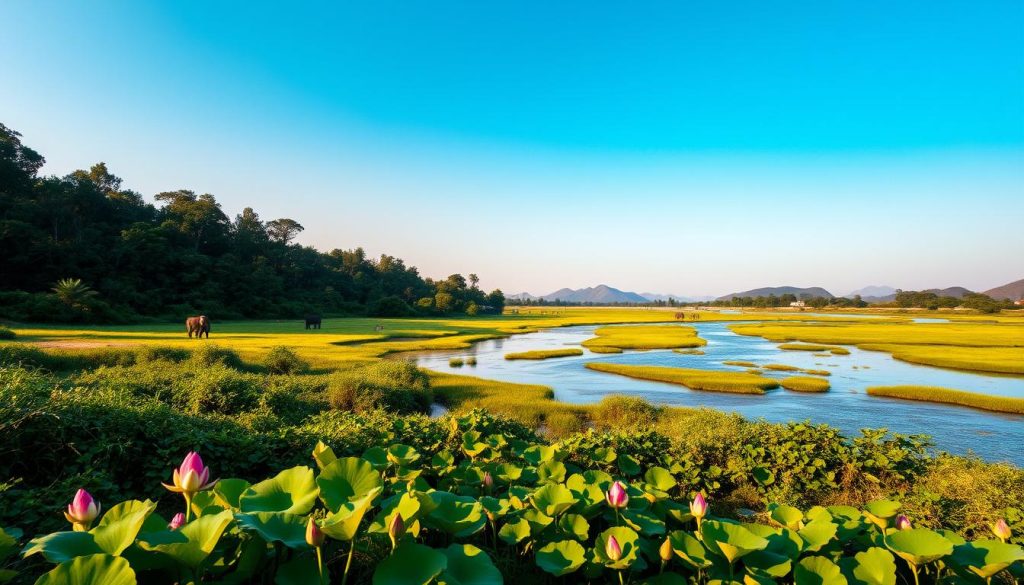
Just 48 kilometers from Guwahati, this sanctuary is a breathtaking spot for nature lovers. Its small size hides its huge ecological importance.
Wildlife Species Diversity
Pobitora Wildlife Sanctuary is famous for its one-horned rhinoceroses. It has about 100 rhinos, making it the densest place for rhinos in the world.
- One-horned Rhinoceros: The sanctuary’s star attraction
- Over 200 bird species for avid birdwatchers
- Diverse grassland and wetland habitats
- Multiple mammalian species
Safari Options
Your wildlife adventure awaits through two primary safari experiences:
- Elephant Safari: Get up close with wildlife
- Jeep Safari: Explore wider sanctuary areas
Conservation Efforts
“Protecting wildlife is not just about saving animals, but preserving entire ecosystems.”
| Conservation Aspect | Details |
|---|---|
| Total Area | 38 sq. kilometers |
| Rhino Population | Approximately 100 |
| Habitat Composition | 40% grassland and wetlands |
| Best Visiting Season | November to April |
Your visit supports critical conservation initiatives. It helps protect these magnificent creatures and their delicate ecosystem. The sanctuary’s ongoing efforts ensure these remarkable species continue to thrive for future generations.
Local Markets and Shopping Districts
Explore the lively shopping scene in Dispur. Here, local markets and shopping districts are filled with unique finds. You’ll discover traditional crafts, modern fashion, and tasty local foods.
Must-Visit Shopping Destinations
- Fancy Bazaar: The oldest and largest flea market in Assam
- Pan Bazaar: Perfect for book lovers and literature enthusiasts
- Maati Centre: Showcasing local handicrafts from North-Eastern states
- Silkalay: Authentic Assamese silk saree destination
Shopping in Dispur is more than buying things. It’s a chance to experience the culture. You’ll find amazing products like handwoven textiles and bamboo crafts. These items show the region’s rich artistic history.
Shopping Highlights
| Market | Speciality | Operating Hours |
|---|---|---|
| Pragjyoti Assam Emporium | Handicrafts from all Assam districts | 10:00 AM – 07:00 PM |
| NEDFi Haat | Local artisan products | 10:00 AM – 10:00 PM |
| Ganeshguri Market | Street food and local products | 10:00 AM – 11:00 PM |
“Shopping in Dispur is more than a transaction – it’s a journey through Assamese culture and craftsmanship.”
Looking for souvenirs or wanting to dive into local shopping? Dispur has it all. You’ll find authentic silk sarees and unique handicrafts. These items tell the story of Assam’s rich culture.
Traditional Assamese Cuisine
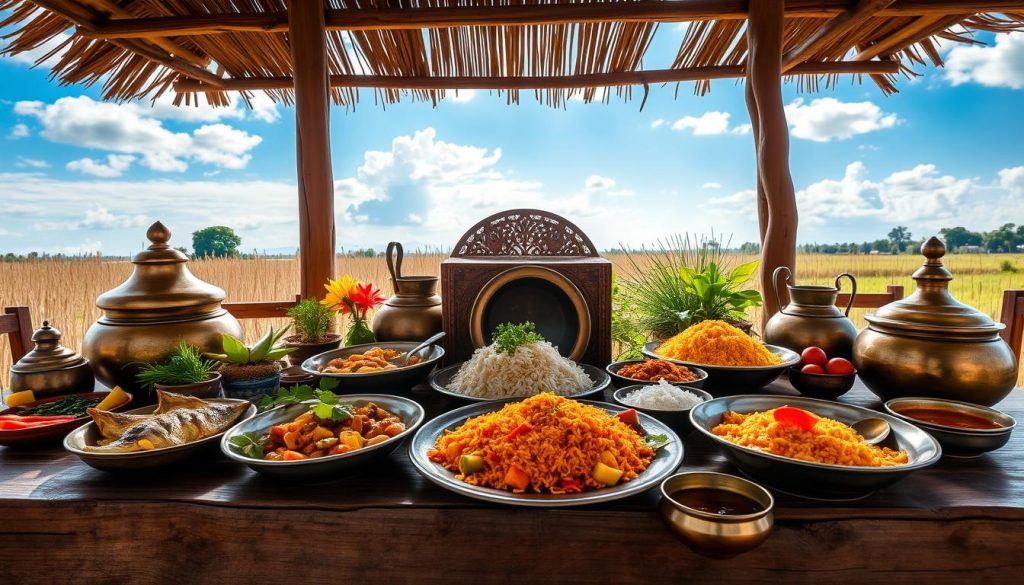
Explore the rich world of traditional Assamese cuisine. It’s a journey that will excite your taste buds with unique flavors. The cuisine is known for its simplicity, fresh ingredients, and special cooking methods. These reflect the region’s cultural diversity.
Signature Dishes to Savor
- Masor Tenga: A tangy fish curry that captures the essence of Assamese cooking
- Khar: An alkaline dish made from raw papaya and dried banana trunk ash
- Pitha: Traditional rice cakes with sweet and savory variations
Discovering Assam’s cuisine is a journey of unforgettable flavors. It uses minimal oil, fresh herbs, and local ingredients. These highlight the region’s rich agriculture.
Top Restaurants for Authentic Flavors
| Restaurant | Price for Two | Established | Google Rating | Signature Dishes |
|---|---|---|---|---|
| Paradise | ₹650 | 1984 | 4.0 | Khar, Pitika, Masor Tenga |
| Heritage Khorikaa | ₹600 | 2014 | 4.1 | Banana Leaf Wrapped Dishes |
| Mising Kitchen | ₹700 | N/A | 4.4 | Mising Chicken Thali |
“Food is our common ground, a universal experience.” – James Beard
Whether you love food or are just curious, Assamese cuisine is unforgettable. It connects you to Assam’s cultural heart.
Brahmaputra River Cruises and Activities
Set off on a Brahmaputra River Cruise for an unforgettable journey. You’ll see the stunning landscapes and rich culture of Assam. The Brahmaputra River gives you a special view of Northeast India’s beauty and heritage.
Types of Cruises
There are many Brahmaputra River Cruise options. You can choose from luxurious multi-day trips or cozy sunset voyages. The MV Mahabaahu is a top choice, known for its comfort and scenic views.
- Luxury Cruises: Multi-day journeys with premium amenities
- Sunset Cruises: Short evening trips capturing magical river views
- Wildlife Exploration Cruises: Focused on observing riverbank ecosystems
Best Viewing Spots
The Brahmaputra River Cruise has amazing spots to see Assam’s landscapes. Key places include:
- Majuli Island – World’s largest river island
- Kaziranga National Park riverbanks
- Umananda Island – World’s smallest river island
Water Activities
There’s more to do than just cruise on the Brahmaputra. Adventure lovers can try:
- River photography
- Bird watching
- Fishing expeditions
- Cultural interactions with riverside communities
“The Brahmaputra is not just a river, it’s a living narrative of Assam’s soul.” – Local River Guide
Conclusion
Your journey through Dispur, Assam, is more than just a trip. It’s a dive into a world of culture, history, and nature. Here, you can explore ancient temples and dive into local traditions.
Located on National Highways 27 and 17, Dispur is a key entry to Northeast India’s wonders. You can see wildlife at the Assam State Zoo, visit historic temples, or enjoy Nehru Park. Each experience in Dispur is unique and unforgettable.
Exploring Dispur, you’ll find layers of history, culture, and beauty. The city’s architecture shows the Ahom kingdom’s influence and modern times. It’s a place that will inspire and enlighten you.
When planning your trip, think of Dispur as more than a place. It’s a chance to see the heart of Northeast India. With its heritage, friendly people, and many attractions, your visit will be memorable.
The above is subject to change.
Check back often to TRAVEL.COM for the latest travel tips and deals.
